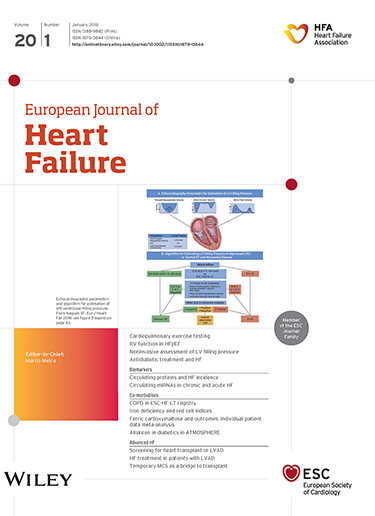心力衰竭和遗传性扩张型心肌病患者致心律失常风险评分的未来发展。ESC心力衰竭协会的科学声明。
IF 10.8
1区 医学
Q1 CARDIAC & CARDIOVASCULAR SYSTEMS
引用次数: 0
摘要
随着新型医疗策略的实施,扩张型心肌病(DCM)患者的心脏性猝死(SCD)风险逐渐下降。然而,仍有病例发生在年轻人中,风险分层的挑战仍未解决。传统的标准,包括左心室射血分数,已经显示出在这种特定情况下识别SCD高风险受试者的严重弱点。越来越多的遗传信息的可用性已经允许识别某些具有高心律失常风险的基因型,值得采用更个性化的方法。最近的欧洲指南承认遗传信息在临床决策中的作用。基因特异性风险分层工具已经开发出来,并且在某些情况下得到了外部验证,可以支持临床医生对SCD一级预防干预措施的决策。然而,它们通常是基于基本变量,而越来越多的关于风险预测新方法的知识,特别是关于心脏磁共振组织特征预测价值的可靠数据(即晚期钆增强)并没有纳入可用的评分,更一般地说,不是临床检查的系统组成部分。在这篇科学声明中,我们总结了目前关于DCM中SCD风险分层的最新技术,特别强调了遗传形式,强调了现有策略的弱点和改进这些策略所需的潜在行动。讨论了可用的风险分层工具,并总结了应纳入未来预测模型的方法。最后,本文逐点总结了未来DCM患者发生心律失常风险评分的关键先决条件。本文章由计算机程序翻译,如有差异,请以英文原文为准。
Future development of arrhythmogenic risk scores in patients with heart failure and inherited dilated cardiomyopathy. A scientific statement of the Heart Failure Association of the ESC.
The risk of sudden cardiac death (SCD) in the general population of patients with dilated cardiomyopathy (DCM) has progressively declined with the implementation of novel medical strategies. However, still cases occur in young individuals and the challenge of risk stratification remains unsolved. Traditional criteria, including left ventricular ejection fraction, have demonstrated their profound weakness to identify subjects at high risk of SCD in this specific context. The increasing availability of genetic information has allowed identification of certain genotypes with a high arrhythmic risk that deserve a more individualized approach. Recent European guidelines recognized the contribution of genetic information in clinical decision-making. Gene-specific risk stratification tools have been developed, and in some cases externally validated, which can support clinicians in the decisions on SCD primary prevention interventions. However, they are generally based on basic variables, whereas the growing amount of knowledge on novel methods for risk prediction, and in particular the solid data on the predictive value of cardiac magnetic resonance tissue characterization (i.e. late gadolinium enhancement) are not incorporated in available scores, and more in general, are not systematically part of the clinical work-up. In this scientific statement, we summarized the current state of the art concerning the risk stratification of SCD in DCM, with particular emphasis on genetic forms, highlight the weaknesses of the available strategies and the potential actions needed for improving them. Available risk stratification tools are discussed, and methodologies that should be incorporated in future prognostication models are summarized. Lastly, a point-by-point summary of the key prerequisites for developing the future arrhythmogenic risk scores in patients with DCM is provided.
求助全文
通过发布文献求助,成功后即可免费获取论文全文。
去求助
来源期刊

European Journal of Heart Failure
医学-心血管系统
CiteScore
27.30
自引率
11.50%
发文量
365
审稿时长
1 months
期刊介绍:
European Journal of Heart Failure is an international journal dedicated to advancing knowledge in the field of heart failure management. The journal publishes reviews and editorials aimed at improving understanding, prevention, investigation, and treatment of heart failure. It covers various disciplines such as molecular and cellular biology, pathology, physiology, electrophysiology, pharmacology, clinical sciences, social sciences, and population sciences. The journal welcomes submissions of manuscripts on basic, clinical, and population sciences, as well as original contributions on nursing, care of the elderly, primary care, health economics, and other related specialist fields. It is published monthly and has a readership that includes cardiologists, emergency room physicians, intensivists, internists, general physicians, cardiac nurses, diabetologists, epidemiologists, basic scientists focusing on cardiovascular research, and those working in rehabilitation. The journal is abstracted and indexed in various databases such as Academic Search, Embase, MEDLINE/PubMed, and Science Citation Index.
 求助内容:
求助内容: 应助结果提醒方式:
应助结果提醒方式:


